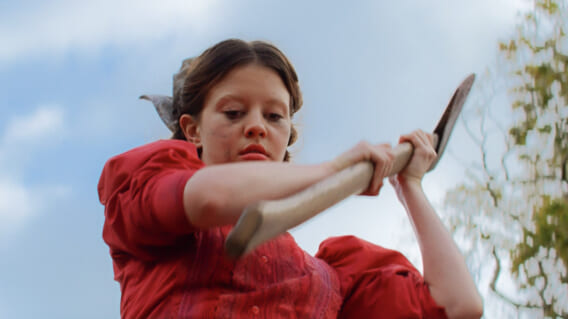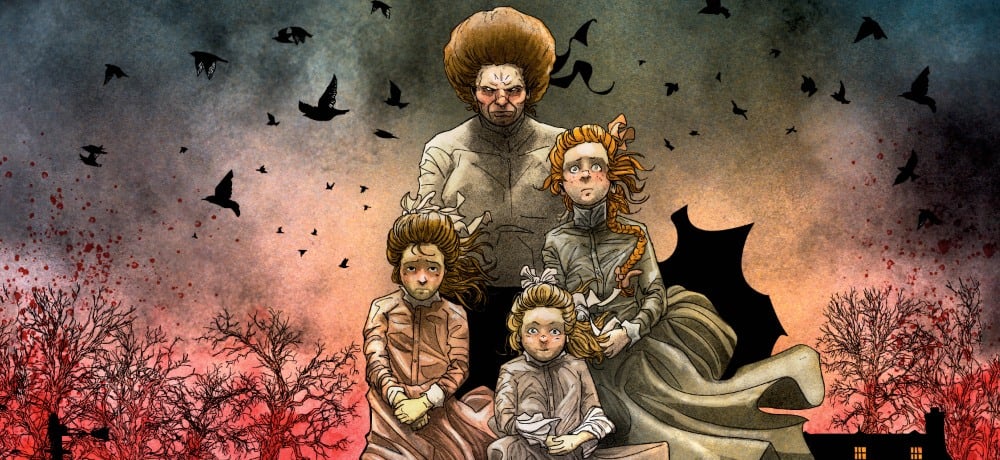‘Strait-Jacket’, ‘Pearl’, and Creating Female Anti-Heroes


This is the third and final part of an article series about female axe murderers in horror. Read part one here and part two here.
In film and TV, swinging the mean end of an axe at polite society results in the kind of psychodrama that satiates an audience’s appetite for the macabre while disrupting their sense of safety. The act of dismemberment is personal and scandalous. Each of the films explored so far build up to this gruesome event in heated fashion. When opportunity presents itself, none of the women reject their willingness to carry out atrocities. Many of the titles discussed offer believable, scathing rebuttals against the treatment of women as sex objects and servants.
In the case of Slut, Chloe Okuno masterfully swerves the killer, and narrow-minded viewers, with the idea that a final girl can hone her sex appeal as a weapon. For the most part, however, these films are bound by the axe—which becomes an extension of each character’s frustration. The Legend of Lizzie Borden melds violence with a sympathetic narrative by embracing the harsh justifications behind the central killings. But it also plays into the idea of murder as an outlet, whereby every victim is nothing less than a statement.
Lizzie Borden, Class, and Race
The trial of Lizzie Borden was a spectacle of tense class and race dynamics that certainly deserves more than a feature’s length of time to tell. But, the best films about the murders are mostly fabricated and they work because they exploit the legend to retrofit the current wave of feminist politics. Lizzie is a patron saint of feminine rage in media. Sensational press coverage notwithstanding, the intimacy of their killings is what makes the best of these films tick. And it is much more interesting to follow Lizzie as a protagonist with cause rather than, say, a patriarchal landowner. The domestic frustrations at the core of Lizzie Borden’s story have inspired countless films, particularly in the horror genre.
Strait-Jacket and Pearl are two of the most comprehensive horror films about how class and gender disparities can lead a family to ruin. Lizzie’s recalcitrant spirit courses them and manifests in a bloody rampage. Yet these films differ from those covered in the previous articles in one key way: neither Pearl nor Joan Crawford’s Lucy Harbin are heroic. And the bodies that surround them do not tell a story of righteous fury.
Strait-Jacket and Popularizing the ‘Psycho Biddy’
William Castle’s Strait-Jacket is one of the more bizarre success stories in a genre where outlandishness is the name of the game. The 1964 film is the second of two Crawford-starring vehicles that launched the “psycho biddy” category in horror and it solidified the genre comeback role as something worthy of prestige. Since Whatever Happened to Baby Jane? and Strait-Jacket, the psycho biddy subgenre has drawn on hysterical elderly women as a source of terror in films like Pete Walker’s Frightmare and, most recently, X.
The novelty of this trope saw Crawford herself try to replicate the success she had with Castle in Berserk (1965), which more or less follows the same plot as her previous film. Though she had consistent work in the entertainment industry leading up to her newfound success in the early 1960s, Crawford’s image was completely re-energized for a modern crowd with her turn as Lucy Harbin—a woman released from a mental institution after 20 years for the killing of her husband with an axe.
!['Strait-Jacket', 'Pearl', and Creating Female Anti-Heroes [Killer Women With An Axe to Grind, Part 3] image 107 960x540 - 'Strait-Jacket', 'Pearl', and Creating Female Anti-Heroes [Killer Women With An Axe to Grind, Part 3]](https://www.dreadcentral.com/wp-content/uploads/2023/05/image-107-960x540.png)
Strait-Jacket is a nightmare account from Lucy’s perspective, as she is gaslit into taking responsibility for the recent killings of people around her upon returning home. If Van Alexander’s theremin-heavy score wasn’t enough of an indication, the surrealist bent of the film’s visuals throws the validity of Lucy’s guilt and innocence into question. By far Castle’s most artistically realized film, and one of Crawford’s most heartbreaking roles, Strait-Jacket’s meta narrative is as important as the story itself. Given that the star is inextricable from the film’s production and marketing, fame and notoriety are central themes.
Meta-Commentary on Stardom in Strait-Jacket
Contrary to the rigged seats and flying skeletons that were cornerstones of Castle’s exhibitions, it was Crawford herself who was the gimmick this time around. According to her publicist Richard Kahn, the star would meticulously organize roadshow events where she would appear on stage either before, in the middle of, or after the film to address the crowd. Noted columnist Dorothy Kilgallen even introduced her in NYC, putting a press-friendly bow on the film’s enduring, nasty imagery. This level of pageantry, of course, is well at odds with Lucy’s experiences in the film.
Written by Psycho author Robert Bloch, the tragedy and rural glamor of Lucy’s life are sharply related to the viewer by Crawford. The star had always made great use of her eyes and could be as cruel or captivating as the situation demanded. What we see of Lucy just before the murder is the old Joan Crawford fans knew and loved. Wistful, strong, a little bit naive, but well suited for whatever challenge she faced. Somewhere between Mildred Pierce and Myra Hudson in Sudden Fear.
That’s When The Killing Started
After the killing, when Lucy debarks the train after 20 years in prison, it’s demoralizing to see what prison does to a woman. And it’s all in the eyes: deep black and disturbed. Lucy goes home to an estranged family. Her daughter Carol (Diane Baker) seemingly tries to make the most of the situation, though she was been when her mother swung the axe at her father and his lover. But the walls close in as soon as people start getting killed.
!['Strait-Jacket', 'Pearl', and Creating Female Anti-Heroes [Killer Women With An Axe to Grind, Part 3] image 108 - 'Strait-Jacket', 'Pearl', and Creating Female Anti-Heroes [Killer Women With An Axe to Grind, Part 3]](https://www.dreadcentral.com/wp-content/uploads/2023/05/image-108.png)
First, the psychiatrist that saw Lucy in prison; then, Krause the farmhand. These deaths are committed in a psychotic spell and achieve nothing other than to make the target on Lucy’s back more visible. From here on, the film is a pulsating drama that tests Lucy’s ability to maintain her facade in front of wealthy, would-be in-laws on the part of Carol’s fiance, Michael.
Tennessee Williams Meets EC Comics
The ending of Strait-Jacket is nothing less than Tennesee WIlliams filtered through an EC Comics aesthetic. After Michael’s parents use their resources to dig up dirt on Lucy–which is what snaky WASPs tend to do–her final confrontation with them lays everything on the line. Up until that point, the reaction from Michael’s mother, Alison (Edith Atwater), about his engagement to Carol is summed up in the frosty line: “I wasn’t aware any decision had been made in this matter.”
But with Lucy’s history, the tension boils to where it shatters the illusion of these two worlds ever co-existing. Alison yells at Lucy and triggers her into a panicked state. But she doesn’t reach for a weapon–which would have been justified. Referencing her time in prison, Lucy puts her foot down and says: “I’m not ashamed. I paid for everything that I did. You’ll never know how much I paid.” At that moment, the realization should dawn on the audience that Lucy hasn’t been behind these killings at all.
!['Strait-Jacket', 'Pearl', and Creating Female Anti-Heroes [Killer Women With An Axe to Grind, Part 3] image 109 960x625 - 'Strait-Jacket', 'Pearl', and Creating Female Anti-Heroes [Killer Women With An Axe to Grind, Part 3]](https://www.dreadcentral.com/wp-content/uploads/2023/05/image-109-960x625.png)
This scene, brilliantly acted by Crawford, challenges your sense of logic as a viewer and you begin to wonder who then if not Lucy? The answer, executed with pulpy panache by Bloch and Castle–is Carol. Carol gambles on a chance at social mobility and risks Lucy’s freedom to do it, going so far as to mold a perfect mask of her mother’s face complete with an identical wig. The frame job continues to the penultimate scene, which follows Carol’s breakdown and ends with a devastated Lucy crying to the camera.
A Challenging Ending
Strait-Jacket’s only misstep is extending the story to imply a happy ending while psychoanalyzing Carol’s actions before the credits roll–much like Psycho only to a less rewarding degree. It’s the kind of finish that reminds you you’re watching an actor flex their creative control. And it treats Lucy’s downtrodden expression as a veil, able to slip off at any moment to reveal that she was okay all along. Personally, I would have preferred ending on a bitter note. Politically, it’s no wonder the film performed well at the box-office.
If one were to romanticize the making of the film, they would say Crawford is the star that got the picture moving and the one who pushed it to the success it deserved. That’s the kind of industry clout dreams are made of and, in real life, Crawford didn’t even have to pick up an axe to own it. The horror of Strait-Jacket is bone-deep, right down to Bloch’s screenplay. And it drives the message home of what a person is willing to do to transcend a life they feel they do not deserve. If Mia Goth’s maniacally self-centered Pearl could have been anyone, she would have preferred to be Joan Crawford. Instead, she was cursed with the Harbin’s plain way of life.
“I Will Not Accept A Life I Do Not Deserve”
Ti West’s Pearl is a monster of a film that, like Strait-Jacket, pushes its protagonist to the brink of madness. It uses grand stylistic inflections as cushion to its most vicious scenes, straddling the border between parody and pastiche. The film relishes in the demented world view of its protagonist and makes a circus of the vibrant nightmares on screen. It’s true carny shit and West didn’t need to go on tour to attract marks.
!['Strait-Jacket', 'Pearl', and Creating Female Anti-Heroes [Killer Women With An Axe to Grind, Part 3] pearl 1 1024x576 - 'Strait-Jacket', 'Pearl', and Creating Female Anti-Heroes [Killer Women With An Axe to Grind, Part 3]](https://www.dreadcentral.com/wp-content/uploads/2022/07/pearl-1-1024x576.jpeg)
Mia Goth’s magnetic screen presence and alluring stare dominates the picture. Her growing impatience at rural living is not a third act reveal. Every living thing around her is in danger of being caught up in her wrath. We sit with nauseating anticipation for the first kill. The opening narration of Strait-Jacket fits Pearl’s narrative as if it were read over her own film:
“Lucy Harbin: born and raised on a farm. Parents poor, education meager. Very much a woman and very much aware of the fact.”
Lucy and Pearl: A Match Made In Hell
The parallels between Pearl and the Harbins don’t end there. After her release, Lucy became a prisoner of others’ gaslighting and the betrayal of her mental state. Carol grew up resenting her birthright–the family farm–and rejecting all the class signifiers that came with it. Pearl is a prisoner, as well. Specifically, of respectability politics and the accompanying behavior expected of a woman with ties to high society. And she must fulfill her obligation, as a child of German immigrants, to not draw negative attention during a pandemic that has made Germans the subject xenophobic scapegoating. Pearl is one of the scariest movie villains of this current era, but she isn’t without her personal baggage. What the film excels at, and what it borrows heavily from Strait-Jacket, is the toll of a self-inflicted wound.
The bleakness of Pearl’s world is softened by her ambitions. Appropriately, the strange approach to the film’s style (Singin’ in the Rain done as a slasher for the 2020s) makes the horrors seem unreal until we are faced with them head-on. The severity of the 1918 H1N1 pandemic, which killed upwards of 50 million people, and the war so traumatic it was dubbed “the war to end war”, are relegated to the background.
This is the stuff most horror films would devour, yet Ti West’s pitch black sense of humor sees him selling an audience a romantic angle on top of a wannabe starlet narrative instead. But the threat is real. Just like Theda–the swamp alligator Pearl named after silent film star Theda Bara–Pearl herself is waiting with open maw to ensnare the perfect opportunity. Despite the carnage that unfolds, it never comes.
A Boring Life On The Farm
Pearl is agitated from the jump, having to work on a farm and take care of her sick father while her husband Howard is away at war. Like Carol, Pearl sees her family as dead weight holding her back from her fullest potential and climbing the social ladder. As a child of immigrants, she understandably doesn’t grasp the full scope of her mother’s worries. This is one of the only instances where Pearl is sympathetic and where the heart of the closing monologue lies. It’s no wonder her mind is warped. The dream of leaving a depressing situation takes priority over anything else because it has to.
!['Strait-Jacket', 'Pearl', and Creating Female Anti-Heroes [Killer Women With An Axe to Grind, Part 3] image 111 960x639 - 'Strait-Jacket', 'Pearl', and Creating Female Anti-Heroes [Killer Women With An Axe to Grind, Part 3]](https://www.dreadcentral.com/wp-content/uploads/2023/05/image-111-960x639.png)
The uncomfortably horny Wizard of Oz scene is anachronistic in a way that plays into the film’s own delusional style, but is also a great indication of where Pearl is mentally. She works out her frustrations in a weird, but innocent, way on the scarecrow before moving on to the Projectionist (David Cornswet).
On the subject of appearances and social anxiety, Pearl doesn’t seem to mind being seen running errands in her overalls. She doesn’t quite get that performance, for people in high society, is a round-the-clock aspect of their lives. She’s authentic to herself but, without groupies, she’s just another farm girl.
Girl Meets Boy, Mom Hates Boy
Meeting the Projectionist, perhaps the only person who sees her and likes her for who she is (to start, anyway), is one of the greatest shocks to Pearl’s ego in the entire film. He can offer her a life outside the farm, but it would be a life of constant travel and potential exploitation. The moment she decides to kill him is cemented the first time he shows her stag films. Far from the magic of her favorite film, “The Place Follies”, the stag films are a creative gutter to Pearl. She doesn’t let on that she’s been insulted right away, however, as she relies on the Projectionist for the only scrap of escapism she has in her life. This too comes at a price.
Ironically, Pearl’s conflict with her mother Ruth (Tandi Wright) is ripped straight out of the Crawford family tell-all film Mommie Dearest. Wright waves an iron hand of cruelty by denying Pearl supper and shutting down her dreams of socializing by proxy when she refuses the roast pig from their wealthy in-laws. Out of the two, Pearl’s father is in her good graces only because he is disabled and can’t weigh in on either side.
When Ruth catches wind of Pearl sneaking out of the house, everything comes apart at once. The dinner scene is a campy masterclass that still manages to sting with choice insults stemming from regrets about motherhood and tending to a husband who cannot take care of himself. The more personal the insults get, the closer the scene edges into violence. The laughter stops when the audience realizes that Pearl is going to destroy her life before it even starts.
Even if you haven’t seen X, a sense of doom overpowers this scene. Like Carol, Pearl makes the decision to ruin her mother’s life and, ultimately, kills her. Carol never got that far. Pearl does not grasp the situation fully, but is able to get the last word when she throws her mother’s burned corpse in the cellar and says: “I want you to remember what it feels like. Because that’s how I felt every time you looked at me.”
The Audition That Broke The Farm Girl’s Back
During Pearl’s audition to be a chorus girl for a traveling church troupe, the heartbreak sets in. After what, in her mind, was an excellent performance, she is soundly rejected and defeatedly goes back home. She’s killed the Projectionist and sunk his car in the swamp, ala Psycho, and she has even suffocated her father to death. Without anyone left to lean on but her sister-in-law, Mitsy (Emma Jenkins-Purro), Pearl unburdens herself of her sins in a terrifying and honest monologue. In it, she abjectly gives in to the notion that she is missing an “x factor” that the rest of the world has, and that all she ever really wanted was to feel safe.
When her mother’s struggles come into play, Ruth’s line from earlier in the film, “life rarely turns out how you expect” resonates harshly. Society is organized in such a way that her family can only make a living as farmers. She burns down several peoples lives, including her own, just to come to the realization that she doesn’t have what it takes to truly leave her home behind. To move beyond safety and overseas, like her lover suggested, would have been too great a risk. Even riskier than having a baby with a man that she admits was supposed to be her ticket off the farm.
!['Strait-Jacket', 'Pearl', and Creating Female Anti-Heroes [Killer Women With An Axe to Grind, Part 3] image 113 960x549 - 'Strait-Jacket', 'Pearl', and Creating Female Anti-Heroes [Killer Women With An Axe to Grind, Part 3]](https://www.dreadcentral.com/wp-content/uploads/2023/05/image-113-960x549.png)
Pearl looks at motherhood, as a concept, with simultaneous contempt and relief when recounting her miscarriage. She comes to terms with the greater details of her life, yet still holds resentment for Mitsy when she questions whether people like her have ever experienced being uncomfortable. To Mitsy, she says: “I hate what it feels like to be me and not you.”
Welcome Home
West deliberately misleads the audience throughout Pearl, but one of the best moments that could be interpreted as both delusion and validation, is when Mitsy lets Pearl go first to audition. It could be that Mitsy wanted to spare Pearl the embarrassment of seeing other girls win, or, she could have forced her into that spotlight to fail in spectacular fashion. The latter strikes me as something a wealthy person would do to prop up their ego, along with the air of falseness in her concern for Pearl at the dinner table. Pearl could’ve seen through that and acted accordingly. Or she could have decided simply to add one more body to the count.
Either way, Mitsy’s fate was sealed the moment she stepped into the house and walked past the maggot infested roast pig. Her death is one of the cruelest. Pearl feeds her ego with it as she does Theda’s famished belly. And when Howard comes home, he has no choice but to accept it. Alistair Sewell plays off of the scene in convincing fashion. Who wouldn’t be scared shitless walking into a house with dead bodies, rotting food and the evil glimmer in the eye of the woman who made it so? The fact that Goth holds her twisted expression through the end credits solidifies the terror.
!['Strait-Jacket', 'Pearl', and Creating Female Anti-Heroes [Killer Women With An Axe to Grind, Part 3] image 110 960x640 - 'Strait-Jacket', 'Pearl', and Creating Female Anti-Heroes [Killer Women With An Axe to Grind, Part 3]](https://www.dreadcentral.com/wp-content/uploads/2023/05/image-110-960x640.png)
Pearl’s line “it’s not about what I want. It’s about making the best of what I have” resonates deeply in a story about broken dreams. She, along with the other women at the center of the films covered in this series, is right to feel unsatisfied and pissed off about it. Revenge is a great motivator to pick up an axe in film. You can clear your demons vicariously through the hero and hope she comes out the other end with less bumps than she’s taken.
Axe Murderers and Anti-Heroes
What Pearl and Strait-Jacket show us is the darker side of an already morbid subject matter. These two films take the plunge into psychological instability and draw scary results. They show us that killers can be relatable, even when we’re not cheering them on. These are the kind of films that force you to reckon with the ugliest parts of yourself, rather than just celebrating the transgression for its own sake. In my brief obsession with media about women axe killers, I couldn’t choose between the Lisas and the Pearls. I can only assure you that they occupy equal space inside my heart.
Categorized: Editorials





